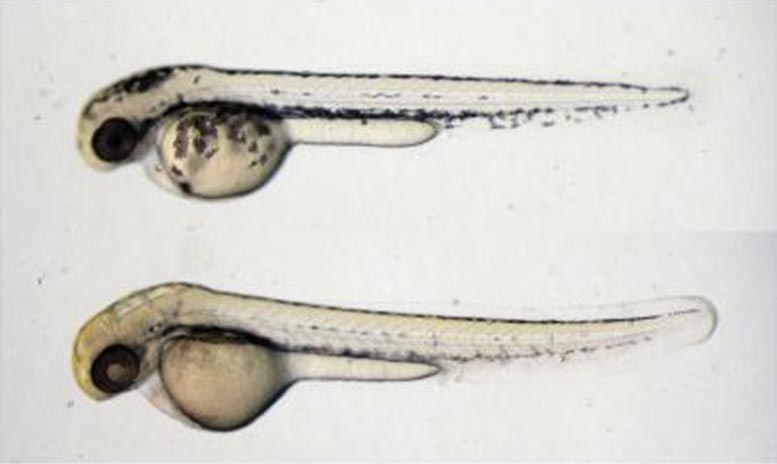As you know I try to keep things simple in this blog. However, this post contains an actual scientific article which may be hard for some to follow. You are always welcome to ask questions.
The study/science of mold (mycology) is an ever evolving, advancing knowledge every year. We know mold can be beneficial in basic ways such as the fermentation of libations and cheese. However, most of us don't think of mold being beneficial in any way in regards to our health. That mindset is changing. What if we can make beneficial drugs using mold. One of the leaders in drug research is Netherlands based Hubrecht Institute.
From Their Article
Zebrafish
Researchers from the group of Jeroen den Hertog at the Hubrecht Institute, in collaboration with researchers from the Westerdijk Institute and Utrecht University, have set up this library and screened it for biologically active compounds. They tested the biological activity of these fungal products first using zebrafish embryos. The researchers chose to use zebrafish embryos, because it allows the analysis of effects on many cell types at the same time, in a working body, and because zebrafish are physiologically very similar to humans. They have already found various known compounds, among which includes the cholesterol-lowering drug lovastatin. The library of fungal products offers ample opportunity to search for new drugs. The results of this research were published on the 26th of November in the scientific journal Scientific Reports.
Fungal products
We constantly need new therapeutic compounds in the clinic for various reasons, including our increasing age, with corresponding illnesses, and resistance to existing drugs. Fungi are an excellent, but underexplored source of these kinds of compounds, such as lovastatin, a compound produced by the fungus Aspergillus terreus and that is used as a cholesterol-lowering drug. Jelmer Hoeksma, one of the researchers at the Hubrecht Institute, explains: “Every year new compounds produced by fungi are identified, but so far we have only investigated a very small subset of all existing fungi. This suggests that many more biologically active compounds remain to be discovered.”

Zebrafish embryos without (top) and with (bottom) addition of a specific fungal filtrate. The zebrafish embryo that was exposed to the fungal filtrate clearly has less pigment. Credit: Jelmer Hoeksma, © Hubrecht Institute
Ten thousand fungi
The collaboration with the Westerdijk Fungal Biodiversity Institute, home to the largest collection of live fungi in the world, enabled the researchers to set up a large library of filtrates derived from more than ten thousand different fungi. A filtrate contains all the products that the fungus excretes. To search for therapeutic compounds, the researchers investigated the effects of this large library of fungal products first on zebrafish embryos. The zebrafish embryos enabled the researchers to study effects on the whole body during development. Zebrafish are vertebrates that are physiologically very similar to humans and are often used to test drugs for a variety of disorders. Within a few days these embryos develop most of their organs, making biological activity of the fungal compounds readily detectable. In addition, comparison to known drugs may result in identification of new drugs and also point towards the underlying mechanisms of action of these compounds.
Pigmentation
The researchers found 1526 filtrates that contain biologically active compounds with an effect on zebrafish embryos, from which they selected 150 filtrates for further analysis. From these, they isolated 34 known compounds, including the cholesterol-lowering drug lovastatin, which was produced by the fungus Resinicium furfuraceum. Until now it was unknown that this fungus produces lovastatin. In addition, the researchers found filtrates that affect pigmentation in zebrafish embryos. Other studies have shown that factors involved in pigmentation can also play a crucial role in the development of skin cancer. The researchers are currently isolating the active compounds that cause pigmentation defects in zebrafish embryos from the filtrates.
Tip of the iceberg
This study underlines the large variety of biologically active compounds that are produced by fungi and the importance of further investigating these compounds in the search for new drugs. Hoeksma: “The large library of fungal filtrates that we have set up can also be tested in many other systems, such as models for antibiotic resistance in bacteria and tumor development, making this study only the tip of the iceberg.”
###
Reference: “A new perspective on fungal metabolites: identification of bioactive compounds from fungi using zebrafish embryogenesis as read-out” by Jelmer Hoeksma, Tim Misset, Christie Wever, Johan Kemmink, John Kruijtzer, Kees Versluis, Rob M. J. Liskamp, Geert Jan Boons, Albert J. R. Heck, Teun Boekhout and Jeroen den Hertog, 26 November 2019, Scientific
This research combines expertise in the fields of developmental biology, fungal cultures, and chemistry in a collaboration between the Hubrecht Institute for Developmental Biology and Stem Cell Research, the Westerdijk Fungal Biodiversity Institute and Utrecht University.
Thanks to all involved for their work and dedication to making our world a better place!


Comments